Challenges to Millennials from Universal Economic Outlook
[Economic Trends of Generation M]

This article intends to briefly predict the international economic trends at the end of the 21st century for readers' reference, especially for the millennial generation. Millennials refer to the generation born between 1980 and 1999. There are an estimated 80 million people in the United States, accounting for a quarter of the total U.S. population (approximately 330 million in June 2015). By the 2030s, Millennials were between the ages of thirty and fifty and were backbone leaders around the world. By the 2050s, Millennials had mostly handed over the leadership to the next generation. The two decades from 2030 to 2050 are a critical period for global economic development. It is foreseen that many global economic crises and environmental crises will occur, which require leadership and resolution by the millennial generation. In fact, many younger generations are thinking about solutions, including developing alternative energy sources to replace non-renewable fossil fuels.
We have seen global economic crises in the past, such as the Great Depression of the 1930s, the energy crises of the early 1970s and early 1980s, and the recent financial tsunami of 2008-2009. We have also seen some relatively small-scale regional financial crises. crises, such as the 1976 East Asian crisis. This article will mention that if we continue to follow the same path in the future, do not change the status quo, put aside our respective interests and work together, the world may fall into a deeper crisis. How to find solutions to various crises and "save" humanity from collapse requires Millennials to foresight and come up with solutions, otherwise the world's economic system may collapse overnight. When discussing the economic crisis, we can also focus on the eschatology of the Bible, understand that God is always in control, and believe that Christianity will always bring the greatest hope to the world.
Due to the large amount of relevant literature, various crises cannot be discussed in detail in the limited space. Here are only a few key points:
1. The economic prosperity of the past two centuries will lead to future economic crises.
This is a paradoxical phenomenon - many economic and environmental problems in the future will actually result from the rapid economic development unseen in the past two hundred years, especially after World War II, when the world experienced unprecedented prosperity.
1. The Industrial Revolution and the Rise of Capitalism
The development of modern economy began around the 1760s, at the same time as Adam Smith published The Wealth of Nations (1776). It was also synchronized with the Industrial Revolution (1760-1840) that started in Britain and spread to Europe and North America. It was also the beginning of the capitalist era.
The Industrial Revolution began with the textile industry, replacing manual work with machines, and then began to develop new chemical manufacturing and other manufacturing industries, using large amounts of coal as energy. These emerging industries not only create employment opportunities, but also significantly increase production. 1 (Due to space limitations, all comments are omitted here and will be published in the online version)
The Industrial Revolution was a turning point in human history, affecting every aspect of human daily life. Average incomes, living standards, and population began to experience unprecedented increases. Countries under the Industrial Revolution experienced a brief decline in population in the early stages of capitalism, but from the late 19th century to the 20th century, population growth increased significantly due to increased fertility and decreased mortality. 2
2. Unprecedented growth in living standards
Economic historian Deirdre McCloskey called it a factor of 16 - the current consumption level of Western society is sixteen times that of London residents in the early eighteenth century: including food, clothing, housing, education, etc. Scholars estimate that the world's per capita national income (measured by gross domestic product, GDP) has barely increased before the rise of capitalism. After thousands of years of stagnation, capitalism began to grow around 1750, first in Northern Europe and the United States, and later throughout the world. 3
Living standards in developing countries have also risen significantly over the past three decades, according to United Nations research. Khalid Malik, the lead author of the report, said: "The Industrial Revolution is a story involving 100 million people (industrial countries), but this (developing country) is a story involving billions of people." 4 This also foreshadows In the future, international political and economic power will gradually shift from advanced countries (North) to developing countries (South).
3. Natural resources are depleted due to economic growth
Modern economic growth requires the input of large amounts of natural resources and labor. Now developed countries (advanced countries, or industrial countries) took the lead in exploiting natural resources in the 19th century to promote the industrial revolution; in the 20th century, energy consumption increased rapidly with economic development. Today, 80% of world energy consumption relies on petrochemical fuels (coal, oil and natural gas, etc.); in addition, there are underground minerals such as rare metals, which are mainly used to produce industrial raw materials. In addition, intensive agriculture will also accelerate the depletion of natural resources, causing forest reduction and water pollution. As living standards improve, population increases, and economic growth grows rapidly, the problems caused by long-term and unrestricted large-scale exploitation of non-renewable natural resources will trigger various crises in the future. 5
The most important natural resource is oil. Humans have discovered oil for thousands of years, but it was not until the mid-19th century that oil was exploited and used on a large scale. Before 1910, large oil reserves were discovered in several countries - including Canada, Indonesia (Dutch rule), Persia, Peru, Venezuela and Mexico. At that time, colonial empires began to extract oil, but coal remained the world's most important fuel until the mid-1950s, when oil rapidly replaced coal. Today, 90% vehicles use petroleum as fuel. In the United States, petroleum also accounts for 40% of total energy consumption, but petroleum only accounts for 2% of power generation. Petroleum has a wide range of uses. In addition to vehicles, it has also become a basic material for industrial chemical products and has become the most important source of raw materials in the world. 6
However, the massive exploitation of natural resources has also caused many problems, including forest reduction and soil desertification, species loss, forced migration (of people and animals), soil erosion, oil depletion, greenhouse effect and global warming, water pollution and natural disasters. 7 Therefore, modern economic growth accompanied by the improvement of living standards, population increase and long-term unrestricted large-scale exploitation of non-renewable natural resources will trigger various crises in the universal future.
Table 1 Global earthquakes exceeding magnitude 6.99 (1863-2014)

Source 1: http://www.earth.webecs.co.uk
Source 2: http://www.earthquake.usgs.gov/earthquakes/eqinthenews/2014/
2. Economic abnormalities lead to future instability and crisis
After the unprecedented rapid economic growth in the past two centuries, there are already several worrying trends that will impose restrictions on future world economic growth, including climate change, overload of the earth's ecological area, environmental crisis, resource depletion and world Redistribution of political and economic power. These trends are all interconnected.
Figure 1 The increase and decrease trend of the minimum value of the Antarctic ozone layer (1980-2015)
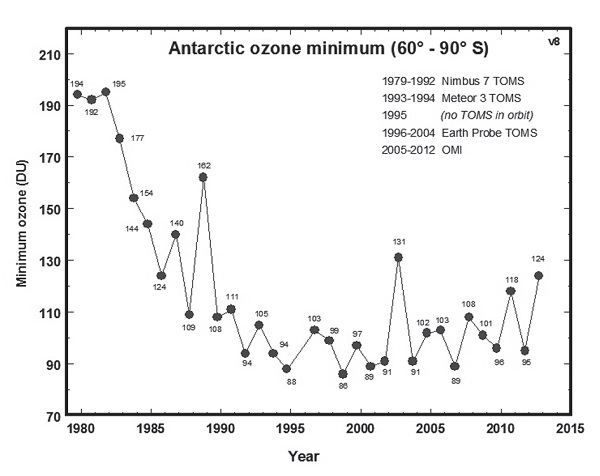
Source: http://en.wikipedia.org/wiki/File:Min_ozone.jpg
1.Climate change─increasing earthquakes and natural disasters
Research shows that climate change is mainly caused by man-made factors and is also responsible for many natural disasters. 8 Former United Nations Secretary-General Annan said: "All parts of the world have always faced natural disasters, but today's natural disasters are mostly caused by human activities, or at least humans make them more serious." 9
earthquake. Since 1990, the frequency of major earthquakes has increased significantly, especially in the past 25 years. 10 (See Table 1) Some earthquakes are related to global warming, such as melting icebergs causing more earthquakes, especially in Greenland. 11
natural disaster. When economies grow and utilize natural resources, the increase in carbon dioxide emissions triggers the greenhouse effect, causing climate anomalies such as powerful storms, climate freezes, and floods in the United States and around the world. 12 The minimum amount of Antarctic ozone has been declining for a long time since the 1970s, with an average decrease of 4% per decade. 13 (Figure 1) Secondly, the frequency of natural disasters in various places has a long-term upward trend, which has also caused heavy losses in product insurance. 14 (Figure 2)
Figure 2 World natural disaster trends (1980-2010)
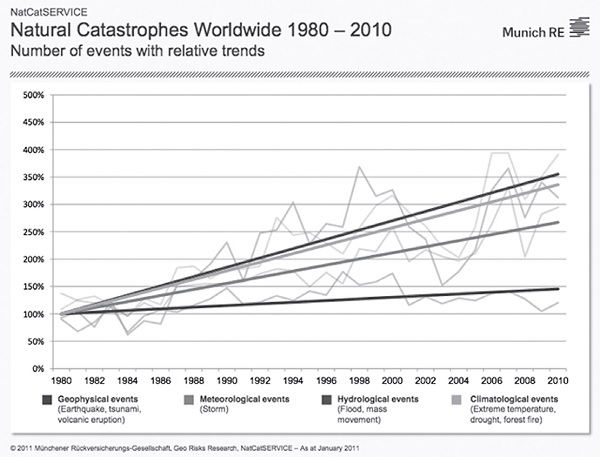
2. Estimation of ecological area─it has exceeded the earth’s carrying capacity
"Ecological footprint" is a standardized measure of human demand on the earth's ecosystem. It is sufficient to provide the land and ocean area required by local populations to produce the resources consumed and absorb the carbon dioxide emitted. 15
The Global Footprint Network (GFN) is an international organization that specializes in estimating the ecological area of more than 100 countries in the world. GFN recently reported that the natural services we need - the use of resources and the production of carbon dioxide - are more renewable and renewable than nature can. The speed of absorption is accelerated by 44%. In other words, the resources used by humans every year require nearly one and a half Earths to meet their needs; or, in other words, it takes eighteen months for the Earth to produce the ecological services humans need for one year.
If humans continue to use natural resources and generate waste at the current rate, by the early 2030s, humans will need the resources of two Earths to meet their needs. This ecological depletion may cause the collapse of ecosystems. 16
Before 1961, the world only used half of the Earth's biocapacity, but today 80% countries use more biocapacity than can be provided within their borders. The average American needs 23 hectares of ecological area, which is approximately 17 American football fields (according to 2009 estimates). If everyone on the planet lived like Americans, the world would need an area of 4.1 Earths to meet the needs. 17 (Figure 3)
Figure 3 Human ecological area (1961-2001)
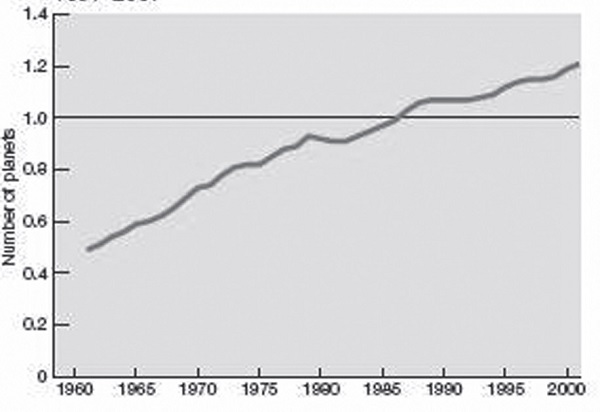
Source: http://en.wikipedia.org/wiki/Ecological_footprint
3. Population growth, frequent famine and poverty
The population increased significantly. The world's population was 1.6 billion in 1990, increased to 2.5 billion in 1950, 6.1 billion in 2000, and was approximately 7.2 billion at the beginning of 2015. The reasons for the substantial increase in population are the use of fossil fuels, industrialization, advances in agricultural technology and medical care, and the immigration of European populations to the Americas. The use of oil, in particular, is a major driver of rapid population growth. 18
According to United Nations estimates, the world's population will reach nine billion by 2050. (Figure 4) Among them, there are 3 billion new middle classes, mainly from emerging countries, such as China and India. These people will increase demand for meat, consumer goods, and urban infrastructure (China recently launched the Asian Infrastructure Investment Bank, claiming that it has US$8 trillion in funding needs, as an example). In response to these new demands, the demand for energy will rise even higher. McKinsey expects global automobile production to double by 2030. 19 Without adequate natural resources to support existing economic growth, population growth will slow down over the next few decades and may reach only 8 billion people by 2050. 20
famine. Although living standards in developing countries have improved significantly in recent decades, a few poor countries still experience famine. According to estimates by the Food and Agriculture Organization of the United Nations, there were 925 million people suffering from hunger around the world in 2010, 981 of which occurred in low-income developing countries or poor areas of developing countries. In 2012, the number dropped to 870 million. The reduction was mainly due to the rapid economic growth. developing Asia and the Pacific, especially China. A quarter of the people suffering from famine are in Africa, but developed countries are also beginning to see an increase in the number of people suffering from famine, rising from 13 million in 2004 to 2006 to 16 million in 2010 to 2012; Up to 20 million. If food becomes increasingly scarce in the future, the number of people suffering from hunger may increase, especially in poor areas. twenty one
poverty. The UN Millennium Summit adopted the UN Millennium Declaration in 2000, and 189 countries and 23 international organizations signed a commitment to help poor countries achieve the eight millennium goals in 2015. The main purpose of development goals is to reduce poverty.
The first goal is the most important: eradicating extreme poverty and hunger. There are three measurable indicators: halving the proportion of people living on less than $1.25 (purchasing power parity) in the 25 years between 1990 and 2015; achieving adequate employment levels for men, women and young people; and the number of people suffering from famine The number is halved. 22 According to the World Bank's assessment, developing countries have halved extreme poverty since 2000, and the first goal was achieved five years ahead of schedule.
However, the early achievement of this milestone is mainly due to the relatively rapid development of China's economy. In Africa and South Asia, regions with relatively slow economic growth have not yet reached the halving target before the deadline. More than one billion people are still in extreme poverty. Many people experience hunger and suffer the consequences of environmental degradation and soaring prices. In addition, high inequality in the distribution of income and wealth will also lead to an increase in the number of poor people and an increase in the number of people suffering from hunger (therefore, there are also people suffering from hunger in developed countries). twenty three
Figure 4 World population trends and future projections
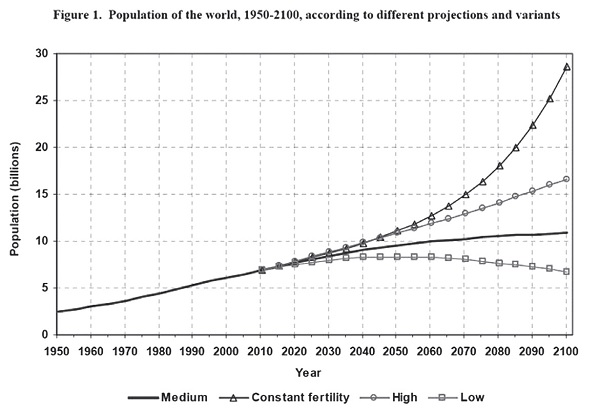
Source: United Nations
4. Other environmental crises
In addition to the above-mentioned crises, there are several environmental crises that affect the world, some of which have already affected the global ecology and human daily life and health. If left unsolved for a long time, mankind will fall into an unprecedented disaster.
In the final analysis, most of these crises are caused by human factors and are the result of modern economic development in the past two centuries. These include the increase in population and the increasing demand for food; the greenhouse effect and climate change due to carbon dioxide emissions and air pollution; the deforestation for industrialization and economic growth, reducing the area of arable land; the use of pesticides, reducing bees; the comprehensive effect is that tropical Rainforests are disappearing rapidly, and the loss of biodiversity is the extinction of many organisms, lack of water sources, increase in drought areas, desertification of land, reduction in arable land; reduction in food production per person; and increase in waste. If the world does not work together to solve each environmental crisis, it will have great harm to the economy and the maintenance of ecological systems (a brief description of each crisis will be published on the website due to space limitations).
5. Resource depletion
Storage capacity of fossil fuels. The world has overused natural resources, especially fossil fuels. At the current rate of use, oil will last 46 years, natural gas 58 years, and coal 118 years. It is expected that oil and natural gas will still be the main energy sources in 2025. twenty four
oil. Economies around the world depend on oil and other fossil fuels. Around 2010, half of the world's oil reserves had been used. In 2030, oil production could fall to half of current levels. There is still much debate over when world oil production peaked. Most analysts believe peak oil production will occur between 2010 and 2020.
Coal and natural gas. Coal and natural gas are also disappearing. Coal can last for a while after the oil is used up, but it is too polluting to be used to fuel most vehicles. Natural gas is not easy to transport and is not suitable for use in most equipment. A large amount of shale gas (natural gas contained in shale formations) has been discovered in the United States, and it has become an increasingly important natural gas energy source in the United States in the past decade. A natural gas supply of 20% was provided in 2010 and is expected to be 46% in 2035. But experts say just using current fossil fuels using current technology would be enough to burn the earth several times. 25
Other minerals. Except for oil, most minerals and non-renewable energy sources in the United States have already exceeded their peak production, including aluminum (peak 1943), copper (1998), iron ore (1951), manganese (1966), phosphosite (1980), Potassium (1967), rare metals (1984), tin (1945), titanium (1964) and zinc (1969). Even if recycled, these resource stocks will continue to decline rapidly.
Solar energy and other renewable alternative energy sources. Global energy consumption in 2012 was approximately 567EJ (exajoule, energy unit, approximately 278 terawatt-hours TWH). It is estimated that the most potential renewable alternative energy sources that can be used each year are solar energy 1575EJ, wind power 640EJ, and geothermal energy 5000EJ. The world's deserts cover an area of about 36 million square kilometers and can absorb 300,000 EJ of solar energy. After electricity conversion, 33,000 EJ of energy can be obtained. However, some scholars believe that both solar and wind power require huge tracts of land to produce the required energy and require continued research. For example, generating 500 EJ of solar energy requires 550,000 square kilometers of land to erect solar panels, which is equivalent to the area of France. It is difficult to control. It is foreseeable that the cost of investing in alternative energy will be relatively higher in the future. 26
Figure 5 The shift in the focus of Christianity (30-2100)
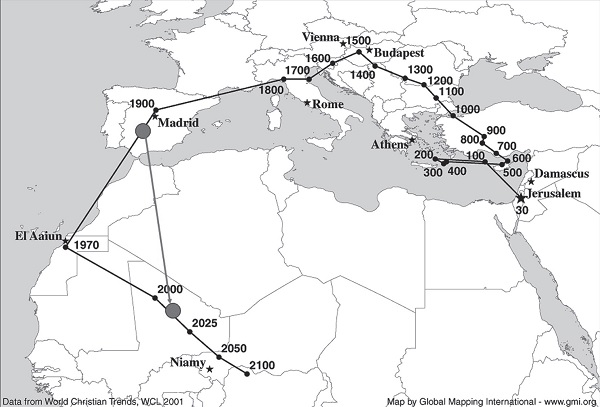
Source: http://www.lausanneworldpulse.com/pdfs/tj_2.pdf
3. The rise and fall of international power
The Shift in Christian Focus. Over the past century, Christians have accounted for only one-third of the world's population. In 1910, the Christian population in Europe and the United States accounted for more than 80% of the world's Christian population. At that time, the center of Christianity was in Europe, that is, the "North" representing advanced countries. However, in recent decades, the center of Christianity has gradually shifted from Europe to Africa. Represents the prosperity of the gospel in the "South" of the world, and its decline in the "North".
In 1910, Europe was still the center of Christianity. At that time, the proportion of Christians in the total population was about 66%. By 2010, it dropped to only 25%; while the proportion of Christians in Africa increased from only 2% to 21.6% during the same period.
Since 1981, "Southern" Christians have become the majority - the Christian population was less than 10% in 1910 and has risen to 50% today. In sub-Saharan Africa, the Christian population exceeds 70%, rising from 12 million in 1910 to 500 million today. The Christian population in Asia has also increased significantly - from about 25 million a hundred years ago to about 360 million today. The Christian population in Europe has declined significantly. It is estimated that in 2050, except for the United States, which will still have more than 300 million Christians, other countries with large Christian populations are today's developing countries, such as China and Brazil. 27 From the perspective of economic development history, God especially blesses countries that are predominantly Christian. The southward shift of Christianity’s center of gravity also means that God’s blessings may shift. (Figure 5)
The decline of developed countries and the rise of developing countries. Developed countries are all countries deeply influenced by Christianity. However, with the decline of Christianity, their political and economic power has also gradually declined. In international institutions and international occasions, emerging developing countries have gradually become equal to advanced countries and participate in international political and economic decision-making. The aging of the population in European and American countries is getting more and more serious, and social welfare expenditures have also increased accordingly, which has affected the fiscal situation of most countries. National debt has also increased rapidly, and economic growth has been flat. The situation is not optimistic about solving the debt problem.
On the other hand, the rapid economic growth of many emerging developing countries in the past few decades (partly due to the long-term support of poor countries by international institutions and advanced countries in the form of foreign aid and trade, making the latter gradually prosperous) has lifted a large part of the population out of poverty, resulting in the Tens of millions of middle-class people, with strong purchasing power, have become economic giants that can compete with developed countries - such as the emerging seven countries (China, India, Brazil, Indonesia, Turkey, Mexico, Russia) or the BRICS (Brazil, Russia , India, China and South Africa).
Economic power has also been transformed into political power, so that the international political and economic decision-making power has been transferred from the original G-7 (the United States, Canada, Britain, France, Germany, Italy, and Japan) to the G-20 ( Established in 1999, that is, in addition to the G-7 plus 13 other countries). According to predictions, the gross national product (GNP) of the emerging seven countries will begin to surpass that of the G7 in 2030. If purchasing power parity is used (local prices in various countries are converted into US dollars using US prices), China's gross national product will surpass the United States in 2016. 28
The decline of political and economic power in European and American countries, and the relative rise of power in developing countries, seem to be related to the decline and rise of Christianity from a religious perspective. In developing countries that have always been poor, after half a century, Christianity has experienced a great revival in Asia, Africa, and Latin America, and has also witnessed the rise of its economic and political power. It can be seen that the places where Christianity arises are also places blessed by God. We can vaguely see God’s hand in control, as Psalm 33:12 says: “Blessed is the nation whose God is the Lord! Blessed is the people whom He has chosen as His inheritance!” 29
4. Conclusion: Reflections of the World Economic Outlook on Millennials
Due to space limitations, this article does not mention the Bible’s predictions of economic prospects, but the Bible mentions wars, famines, and earthquakes in the last days in several passages, and also hints at the occurrence of high inflation (for example, the Gospel of Matthew 24:6-8; Luke 14:38-39; Revelation 6:5-6).
Rapid economic development over the past two hundred years has indeed blessed advanced countries. But John Wesley had long predicted that when Christianity spread, it would lead to good habits of hard work and thrift, and thus wealth. But wealth would create a love for the world, which would destroy Christianity. The way to avoid this kind of fate is not only to make as much money and save as much as possible, but also to give as much as possible to avoid suffering the curse of hell (Sermon 116) 30.
Advanced countries that have been deeply baptized by Christianity are like the Israelites. They began to betray the God who made them rich, began to love the world rather than God, and gradually left Christianity, with disastrous consequences. On the other hand, developing countries that were originally poor began to believe in Christ, and were blessed by God and began to become wealthy, and competed with advanced countries on the international stage. Just like Moses declared in Deuteronomy 28, "The Israelites obeyed God's commandments. "If you break a commandment, you will be blessed; if you break it, you will be cursed."
Some futurists have also warned that the world economic system may collapse overnight because it cannot withstand various crises coming at the same time and countries around the world are unwilling to work together for their own interests, just like the doomsday signs mentioned in the Bible. No matter how the world situation changes, the next few decades will happen to be the era when the Millennial generation will take over the leadership. Therefore, the author recommends that Millennials: First of all, strengthen their faith, trust in the salvation of Jesus Christ, commit themselves to Christ, acknowledge the sovereignty of Jesus over our lives and all our money, career and family, and be determined to be loyal, kind and useful. Knowledgeable and wise, good stewards. Secondly, we must be prepared to face many crises in the future and believe that the Lord will give us wisdom to solve them. Even if it is not the case, we must trust God’s guidance and move toward the future with peace and joy in our hearts.
 Author's profile Wen Yingqian is the Chairman of the Board of Directors of the Christian Association in the United States and Taiwan. Editor of the talent unit of this magazine. Honorary professor of the Department of Economics and Finance of Donghua University in Taiwan, director of the American Chinese Outreach Ministry of Crown Financial Ministries, and director of the Christian Messengers Association.
Author's profile Wen Yingqian is the Chairman of the Board of Directors of the Christian Association in the United States and Taiwan. Editor of the talent unit of this magazine. Honorary professor of the Department of Economics and Finance of Donghua University in Taiwan, director of the American Chinese Outreach Ministry of Crown Financial Ministries, and director of the Christian Messengers Association.
